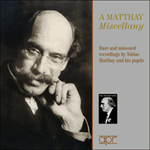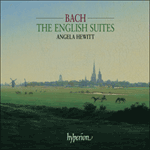
Welcome to Hyperion Records, a British classical label devoted to presenting high-quality recordings of music of all styles and from all periods from the twelfth century to the twenty-first.
Hyperion offers both CDs, and downloads in a number of formats. The site is also available in several languages.
Please use the dropdown buttons to set your preferred options, or use the checkbox to accept the defaults.

The theme of the Allemande appears for the first time, rather unusually, in the bass. Taken up by the right hand, it is then swapped back and forth between the hands. After the double bar it is inverted, but then returns to its original form before the end. Bach flaunted his disregard for the rules and wrote a pair of consecutive octaves going into bar 11 that must have shocked his students! The Courante is rhythmically complex, with one passage in the first section sounding as though we are suddenly in 4/4 time rather than 3/2. The Sarabande is truly magical and must be one of his most inspired examples of this dance. The pedal point at the beginning lasts a full seven bars, and requires some repetition of the low G if it is to continue sounding. There are swift changes of key, and enharmonic progressions over a second pedal point that add to its beauty. As in the second suite, Bach gives us fully written-out ‘agréments’ which this time I like to play after a full, repeated version of the original dance. That way it somehow seems like a distant ‘echo’ of what has come before, yet even more wondrous and expressive.
The two Gavottes are well known—probably the best known movements in all the English suites. The first makes you think of Rameau’s famous Tambourin with the insistent, drum-like repeated Gs in the bass. The second is a musette in the major key which has a tender, almost lullaby-ish character. It is always preferable, I think, to play the pair of galanteries at the same speed, so this second gavotte prevents you from taking the first one too fast. The Gigue is in fact a three-part fugue of great difficulty which needs clarity, precision, and a sense of line to be effective. This is definitely one movement in which the constant ‘hammering and rattling’ that Forkel talks about can be most distressing!
from notes by Angela Hewitt © 2003
Le thème de l’Allemande apparaît pour la première fois à la basse, ce qui sort plutôt de l’ordinaire. Repris à la main droite, il est ensuite échangé entre les deux mains. Après la double barre, il est inversé pour ne réapparaître dans sa forme originale qu’à la fin. Bach fait preuve de son mépris des règles en écrivant une paire d’octaves consécutives en allant vers la mesure 11 qui a dû choquer ses étudiants! La Courante est complexe du point de vue rythmique, avec un passage dans la première section qui donne l’impression d’être brusquement passé à 4/4 au lieu de rester à 3/2. La Sarabande est vraiment magique. Voici un des exemples les plus inspirés de cette danse. La pédale du début dure pendant sept mesures entières et requière quelque répétition du sol grave pour continuer à la faire sonner. On y trouve de brusques modulations et des progressions enharmoniques sur une seconde pédale, ce qui rehausse sa beauté. Comme dans la seconde suite, Bach écrit tous les agréments que je préfère jouer, cette fois-ci, après une version intégralement reprise de la danse originelle. De cette manière, on a l’impression d’entendre un «écho» lointain de ce qui a été joué, avec encore plus d’expressivité et de merveilleux.
Les deux Gavottes sont des pièces illustres—d’ailleurs, il s’agit probablement des mouvements les plus connus des Suites anglaises. La première fait penser au célèbre Tambourin de Rameau avec ses répétitions insistantes à la basse de sol aux allures de percussion. La seconde est une musette en majeur au climat tendre évoquant presque une berceuse. C’est toujours préférable, je pense, de jouer les paires de galanteries à la même allure, si bien que cette seconde gavotte empêche de prendre la première à un tempo trop rapide. La Gigue est en fait une fugue à trois voix d’une très grande difficulté qui, pour être efficace, exige clarté, précision et un sens de la ligne. Voici certainement un mouvement où «le martèlement et le cliquetis constants» que Forkel évoquait dérangeraient le plus!
extrait des notes rédigées par Angela Hewitt © 2003
Français: Isabelle Battioni
Das Thema der Allemande erklingt erstmals, was recht ungewöhnlich ist, in der Bassstimme. Es wird darauf von der rechten Hand aufgegriffen und dann zwischen beiden Händen hin- und hergereicht. Nach dem Doppelstrich erscheint es in der Umkehrung, kehrt dann aber vor Ende zu seiner Originalform zurück. Bach stellte sein Missachten der Regeln zur Schau, indem er im Übergang zum elften Takt zwei Oktaven im Parallelgang setzte, was seine Schüler schockiert haben muss! Die Courante hat eine komplexe rhythmische Struktur: eine Passage des ersten Teils klingt so, als befänden wir uns plötzlich im 4/4-Takt und nicht in 3/2. Die Sarabande ist wahrhaft bezaubernd und muss eines der inspiriertesten Exemplare dieses Tanzes sein. Der Orgelpunkt am Anfang hält ganze sieben Takte an und muss mehrmals angeschlagen werden, wenn das tiefe G noch zu hören sein soll. Zu der Schönheit des Satzes tragen außerdem rasche Tonartenwechsel sowie enharmonische Fortschreitungen über einem zweiten Orgelpunkt bei. Ebenso wie in der zweiten Suite schreibt Bach auch hier seine „agréments“ aus, die ich diesmal nach dem eigentlichen Tanz und seinen Wiederholungen gespielt habe. Auf diese Weise erscheinen sie wie ein entferntes „Echo“ des zuvor Gehörten, jedoch noch wunderbarer und expressiver.
Die beiden Gavotten sind bekannt—wahrscheinlich sind sie die bekanntesten Sätze der Englischen Suiten überhaupt. Die erste erinnert mit ihren insistierenden, trommelartigen Gs in der Bassstimme an Rameaus berühmtes Tambourin. Die zweite ist eine Musette in Dur mit einem sanften, fast schlafliedhaften Charakter. Es ist meiner Meinung nach immer von Vorteil, beide Galanterien im selben Tempo zu spielen, so dass in diesem Fall die erste Gavotte nicht zu schnell genommen wird. Die Gigue ist eine schwierige, dreistimmige Fuge, die nur durch Klarheit, Präzision und einem Gespür für Stimmführung ihre Wirkung erzielen kann. Es ist dies gewiss ein Satz, in dem das von Forkel kritisierte „Poltern und Klappern“ sehr unangenehm wäre.
aus dem Begleittext von Angela Hewitt © 2003
Deutsch: Viola Scheffel
 Bach: Angela Hewitt plays Bach Bach: Angela Hewitt plays BachAngela Hewitt’s acclaimed recordings of Bach on the piano have received the highest critical acclaim and found their way into thousands of homes, selling nearly 400,000 copies since her recording of the Inventions burst onto the scene in 1994. Now ...» More |
 A Matthay Miscellany - Rare and unissued recordings by Tobias Matthay and his pupils A Matthay Miscellany - Rare and unissued recordings by Tobias Matthay and his pupilsThis final volume of 'The Matthay Pupils' presents most of his remaining students who left recordings, as well as the few discs Matthay himself made. Of particular interest is a selection from the almost unknown AFMC label which was affiliated to ...» More |
 Bach: The English Suites Bach: The English Suites |

